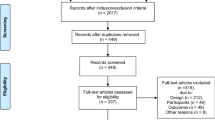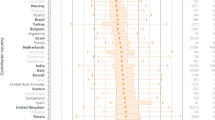Abstract
Background
The prevalence of colorectal cancer in the elderly is increasing and, therefore, surgical interventions with a risk of potential complications are more frequently performed. This study investigated the role of low skeletal muscle mass (sarcopenia), muscle quality, and the sarcopenic obesity as prognostic factors for postoperative complications and survival in patients with resectable colon cancer.
Methods
We conducted a retrospective chart review of 91 consecutive patients who underwent an elective open colon resection for cancer with primary anastomosis between 2011 and 2013. Skeletal muscle mass was measured as total psoas area (TPA) and total abdominal muscle area (TAMA) at three anatomical levels on the preoperative CT scan. Skeletal muscle quality was measured using corresponding mean Hounsfield units (HU) for TAMA. Their relation with complications (none vs one or more), severe complications, and survival was analyzed.
Results
The study included 91 patients with a mean age of 71.2 ± 9.7 years. Complications were noted in 55 patients (60 %), of which 15 (16.4 %) were severe. Lower HU for TAMA, as an indicator for impaired skeletal muscle quality, was an independent risk factor for one or more complications (all P ≤ 0.002), while sarcopenic obesity (TPA) was an independent risk factor for severe complications (all P ≤ 0.008). Sarcopenia was an independent predictor of worse overall survival (HR 8.54; 95 % confidence interval (CI) 1.07–68.32).
Conclusion
Skeletal muscle quality is a predictor for overall complications, whereas sarcopenic obesity is a predictor for severe postoperative complications after open colon resection for cancer. Sarcopenia on itself is a predictor for worse overall survival.


Similar content being viewed by others
References
Ferlay J, Soerjomataram I, Ervik M, Dikshit R, Eser S, Mathers C, Rebelo M, Parkin DM, Forman D, Bray, F GLOBOCAN 2012 v1.0, cancer incidence and mortality worldwide: IARC CancerBase No. 11 [Internet]. Lyon, France: International Agency for Research on Cancer; 2013. Available from: http://globocan.iarc.fr, accessed on 13/12/2013
Henneman D, Snijders HS, Fiocco M, van Leersum NJ, Kolfschoten NE, Wiggers T et al (2013) Hospital variation in failure to rescue after colorectal cancer surgery: results of the Dutch Surgical Colorectal Audit. Ann Surg Oncol 20(7):2117–2123
van Vledder MG, Levolger S, Ayez N, Verhoef C, Tran TC, Ijzermans JN (2012) Body composition and outcome in patients undergoing resection of colorectal liver metastases. Br J Surg 99(4):550–557
Prado CM, Lieffers JR, McCargar LJ, Reiman T, Sawyer MB, Martin L et al (2008) Prevalence and clinical implications of sarcopenic obesity in patients with solid tumours of the respiratory and gastrointestinal tracts: a population-based study. Lancet Oncol 9(7):629–635
Lieffers JR, Bathe OF, Fassbender K, Winget M, Baracos VE (2012) Sarcopenia is associated with postoperative infection and delayed recovery from colorectal cancer resection surgery. Br J Cancer 107(6):931–936
Baumgartner RN, Wayne SJ, Waters DL, Janssen I, Gallagher D, Morley JE (2004) Sarcopenic obesity predicts instrumental activities of daily living disability in the elderly. Obes Res 12(12):1995–2004
Villareal DT, Banks M, Siener C, Sinacore DR, Klein S (2004) Physical frailty and body composition in obese elderly men and women. Obes Res 12(6):913–920
American Joint Committee on Cancer (2014) Colon and rectum cancer staging. www.cancerstaging.org/staging/ Consulted March 12th
Factsheet: Obesity and overweight [Internet]. World Health Organization; 2013 [cited 2014 Feb 6] Available from: http://www.who.int/mediacentre/factsheets/fs311/en/
Charlson ME, Pompei P, Ales KL, MacKenzie CR (1987) A new method of classifying prognostic comorbidity in longitudinal studies: development and validation. J Chron Dis 40(5):373–383
Clavien PA, Barkun J, de Oliveira ML, Vauthey JN, Dindo D, Schulick RD et al (2009) The Clavien-Dindo classification of surgical complications: five-year experience. Ann Surg 250(2):187–196
Englesbe MJ, Lee JS, He K, Fan L, Schaubel DE, Sheetz KH et al (2012) Analytic morphomics, core muscle size, and surgical outcomes. Ann Surg 256(2):255–261
Lee JS, He K, Harbaugh CM, Schaubel DE, Sonnenday CJ, Wang SC et al (2011) Frailty, core muscle size, and mortality in patients undergoing open abdominal aortic aneurysm repair. J Vasc Surg 53(4):912–917
Peng PD, van Vledder MG, Tsai S, de Jong MC, Makary M, Ng J et al (2011) Sarcopenia negatively impacts short-term outcomes in patients undergoing hepatic resection for colorectal liver metastasis. HPB (Oxford) 13(7):439–446
Mitsiopoulos N, Baumgartner RN, Heymsfield SB, Lyons W, Gallagher D, Ross R (1998) Cadaver validation of skeletal muscle measurement by magnetic resonance imaging and computerized tomography. J Appl Physiol (1985) 85(1):115–122
Taaffe DR, Henwood TR, Nalls MA, Walker DG, Lang TF, Harris TB (2009) Alterations in muscle attenuation following detraining and retraining in resistance-trained older adults. Gerontology 55(2):217–223
Jaap J, Hunsinger M et al (2014) Morphometric predictors of morbidity following pancreatectomy. Poster session was presented at: 67th SSO Annual Cancer Symposium; March 12–15; Phoenix, AZ
Gendall KA, Raniga S, Kennedy R, Frizelle FA (2007) The impact of obesity on outcome after major colorectal surgery. Dis Colon Rectum 50(12):2223–2237
Ragg JL, Watters DA, Guest GD (2009) Preoperative risk stratification for mortality and major morbidity in major colorectal surgery. Dis Colon Rectum 52(7):1296–1303
Killingback M, Barron P, Dent O (2002) Elective resection and anastomosis for colorectal cancer: a prospective audit of mortality and morbidity 1976–1998. ANZ J Surg 72(10):689–698
Cai Y, Zhou Y, Li Z, Xiang J, Chen Z (2013) Surgical outcome of laparoscopic colectomy for colorectal cancer in obese patients: a comparative study with open colectomy. Oncol Lett 6(4):1057–1062
Mullen JT, Davenport DL, Hutter MM, Hosokawa PW, Henderson WG, Khuri SF et al (2008) Impact of body mass index on perioperative outcomes in patients undergoing major intra-abdominal cancer surgery. Ann Surg Oncol 15(8):2164–2172
Jaarrapportage DSCA 2012. [Internet] Dutch Institute for Clinical Auditing, 2012. [Cited 2014 May 27] Available from: http://www.clinicalaudit.nl/jaarrapportage/#dica_rapportages_dsca
Balentine CJ, Marshall C, Robinson C, Wilks J, Anaya D, Albo D et al (2010) Validating quantitative obesity measurements in colorectal cancer patients. J Surg Res 164(1):18–22
Bijlsma AY, Meskers CG, Ling CH, Narici M, Kurrle SE, Cameron ID et al (2013) Defining sarcopenia: the impact of different diagnostic criteria on the prevalence of sarcopenia in a large middle aged cohort. Age (Dordr) 35(3):871–881
Bijlsma AY, Meskers CG, van den Eshof N, Westendorp RG, Sipila S, Stenroth L et al (2014) Diagnostic criteria for sarcopenia and physical performance. Age (Dordr) 36(1):275–285
Delmonico MJ, Harris TB, Visser M, Park SW, Conroy MB, Velasquez-Mieyer P et al (2009) Longitudinal study of muscle strength, quality, and adipose tissue infiltration. Am J Clin Nutr 90(6):1579–1585
Reisinger KW, van Vugt JL, Tegels JJ, Snijders C, Hulsewe KW, Hoofwijk AG et al (2014) Functional compromise reflected by sarcopenia, frailty, and nutritional depletion predicts adverse postoperative outcome after colorectal cancer surgery. Ann Surg Mar 19
Sabel MS, Terjimanian M, Conlon AS, Griffith KA, Morris AM, Mulholland MW et al (2013) Analytic morphometric assessment of patients undergoing colectomy for colon cancer. J Surg Oncol 108(3):169–175
Visser M, van Venrooij LM, Vulperhorst L, de Vos R, Wisselink W, van Leeuwen PA et al (2013) Sarcopenic obesity is associated with adverse clinical outcome after cardiac surgery. Nutr Metab Cardiovasc Dis 23(6):511–518
Peng P, Hyder O, Firoozmand A, Kneuertz P, Schulick RD, Huang D et al (2012) Impact of sarcopenia on outcomes following resection of pancreatic adenocarcinoma. J Gastrointest Surg 16(8):1478–1486
Englesbe MJ, Patel SP, He K, Lynch RJ, Schaubel DE, Harbaugh C et al (2010) Sarcopenia and mortality after liver transplantation. J Am Coll Surg 211(2):271–278
Bigaard J, Frederiksen K, Tjonneland A, Thomsen BL, Overvad K, Heitmann BL et al (2004) Body fat and fat-free mass and all-cause mortality. Obes Res 12(7):1042–1049
Mayo NE, Feldman L, Scott S, Zavorsky G, Kimdo J, Charlebois P et al (2011) Impact of preoperative change in physical function on postoperative recovery: argument supporting prehabilitation for colorectal surgery. Surgery 150(3):505–514
Acknowledgments
The authors thank Prof. A. Maier, Department of Internal Medicine–Section of Gerontology and Geriatrics, VU University Medical Center, Amsterdam, Netherlands, for her comments and suggestions.
Author information
Authors and Affiliations
Corresponding author
Ethics declarations
Conflict of interest
The authors declare that they have no conflict of interest.
Rights and permissions
About this article
Cite this article
Boer, B.C., de Graaff, F., Brusse-Keizer, M. et al. Skeletal muscle mass and quality as risk factors for postoperative outcome after open colon resection for cancer. Int J Colorectal Dis 31, 1117–1124 (2016). https://doi.org/10.1007/s00384-016-2538-1
Accepted:
Published:
Issue Date:
DOI: https://doi.org/10.1007/s00384-016-2538-1




